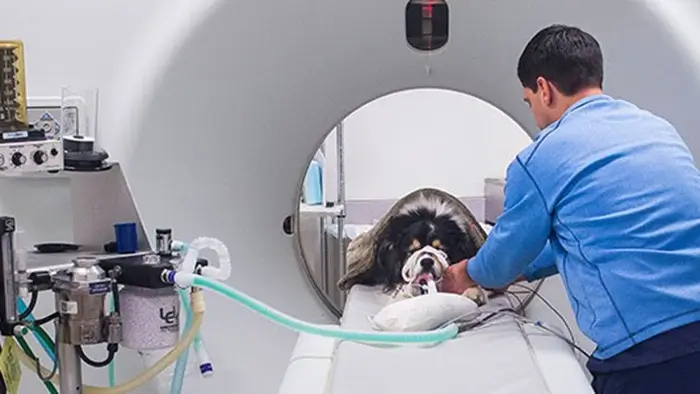Development status and future of China’s pet medical imaging industry

1. Pet medical imaging industry chain
Pet medical imaging uses a specific medium to present pets’ internal tissue structure and density in an image format to assist doctors in diagnosis and treatment. The upstream of the pet medical imaging industry chain is raw material suppliers, the midstream is pet medical imaging equipment manufacturers, and the downstream is mainly pet hospitals.
2. Upstream of the pet medical imaging industry chain
Pet hospitals belong to the consumer market, and the advanced level of medical equipment in pet hospitals often directly determines the turnover. Pet medical equipment mainly focuses on two primary directions: medical imaging and in vitro diagnosis. Pet medical imaging equipment includes B-ultrasound, DR, MRI, CT, and other equipment.
The upstream of pet medical imaging includes electronic devices and consumables. Consumables include steel, chemical raw materials, biomedical materials, non-ferrous metals, etc. Electronic devices are divided into core electronic devices (X-ray tubes, flat panel detectors, high-voltage generators, superconducting magnets, etc.) and non-core electronic devices (sensors, CPUs, batteries, screens, acoustic modules, optical modules, etc.).
There are many suppliers of non-core electronic devices, such as steel, chemical raw materials, and biomedical materials, and the market supply is sufficient.
As a critical upstream component, core electronic devices account for many pet medical imaging equipment costs. For example, the cost of MRI core electronic devices accounts for about 40%-60%, DR core electronic gadgets account for about 30-60%, and CT core electronic devices even exceed 60%.
3. Midstream of the pet medical imaging industry chain
Pet medical imaging is based chiefly on the principles of human equipment and then extended to the pet field. Therefore, the midstream manufacturers in the pet medical imaging market are mostly medical equipment giants. Among them, overseas companies such as General Electric Healthcare, Philips Healthcare, and Siemens Healthcare are relatively mature and occupy a leading position in the mid-to-high-end market of China’s pet medical imaging industry. Compared with overseas companies, China’s local pet medical imaging companies started late and are still in the development stage.
Unlike human medical imaging equipment, supported by the state when the hospital purchases it, the pet hospital purchases pet medical imaging alone, so it usually undergoes more stringent cost accounting. Domestic pet medical imaging equipment is cheaper and more cost-effective than imported one. As domestic companies begin to enter the research and development of high-end pet medical equipment, many pet hospitals begin to consider domestically produced equipment when purchasing equipment. High-end equipment and pet medical imaging equipment are gradually moving towards localization.
For example, “China’s first ultra-high field animal magnetic resonance system uMR9.4T,” independently developed by United Imaging Medical, is used in magnetic resonance imaging of mice, rabbits, monkeys, and other small animals in the fields of life sciences, biomedicine, and preclinical research.
Mindray Medical established Shenzhen Mindray Animal Medical Technology Co., Ltd. and announced its full-scale entry into pet medical care. Before this, Mindray had made breakthroughs in the field of veterinary equipment. It has released a new generation of veterinary four-differentiation blood cell analyzer BC-30Vet, more than four veterinary monitoring products, more than ten veterinary ultrasound products, and launched A variety of veterinary diagnostic instruments, etc.
4. Downstream of the pet medical imaging industry chain
Against the social background of an aging population, the age of marriage continues to be postponed, and the proportion of people living alone is gradually increasing. People’s demand for companionship with pets continues to grow, and the penetration rate of pet ownership increased from 5-8% in 2010 to approximately 19% in 2019.
The scale of domestic pet ownership has expanded significantly, and more than 90% of pet owners take their pets as family members or friends. With disposable income growth, pet owners’ willingness to consume pets increases. At the same time, the increasing awareness of scientific pet care has promoted the development of the pet medical industry and increased the demand for pet medical imaging.
However, limited medical resources and generally high imaging examination costs at this stage have hindered the release of market demand for some pet medical imaging.
Pet medical imaging has high requirements on the environment of operating. For example, some equipment, such as CT and MRI, require a closed environment to operate, and CT has high requirements on the rated capacity of the power supply, which requires additional costs to apply for capacity expansion. In addition, the price of pet medical imaging equipment is relatively high, and hospitals also charge relatively high fees for testing. For example, the price of a single X-ray examination is around 150 yuan/$21, the single price of an ultrasound examination ranges from 150-800 yuan/$21-$110, the average cost of a CT examination can reach 1,500-3,500 yuan/$215-$500 each time, and the price of a single magnetic resonance examination is 1,500-3,000 yuan/$215-$430.Not all individuals with pets can or are willing to bear the relevant expenses. When hospitals consider factors such as the needs of the target audience, operation and management costs, hospital area, physician skills, and qualifications, they will usually choose to prioritize X-ray machines and ultrasound equipment. The current configuration rate of CT and MRI is still relatively low.
In the future, with the gradual popularization of domestic pet medical insurance and the reduction of pet owners’ medical burden, the market demand for pet medical imaging equipment is expected to be rapidly released.
